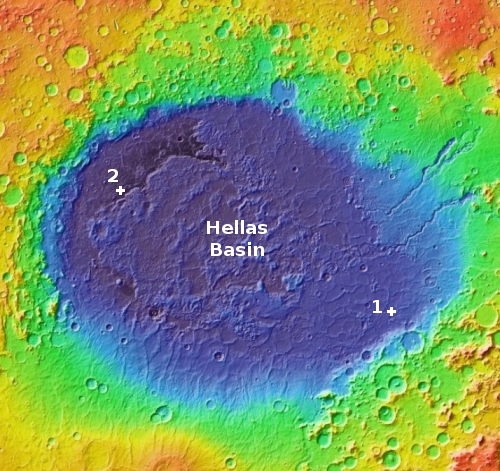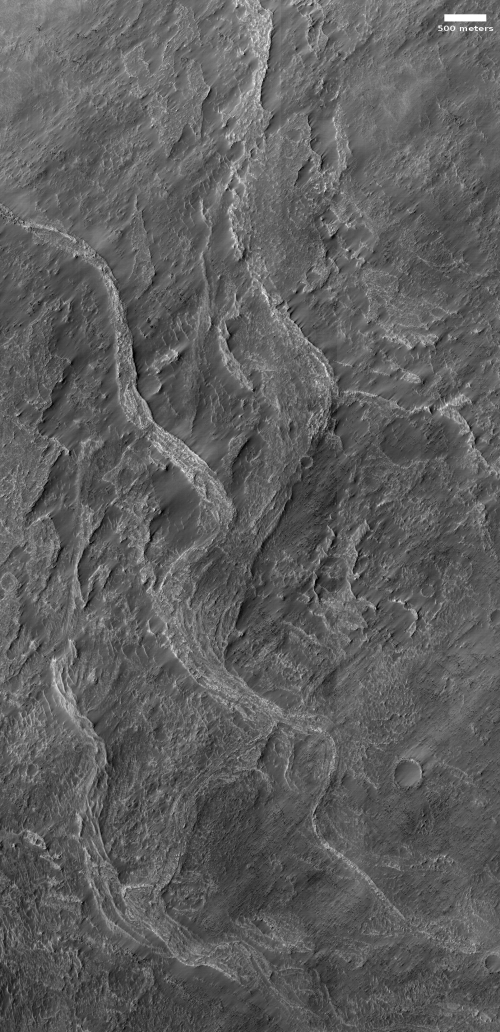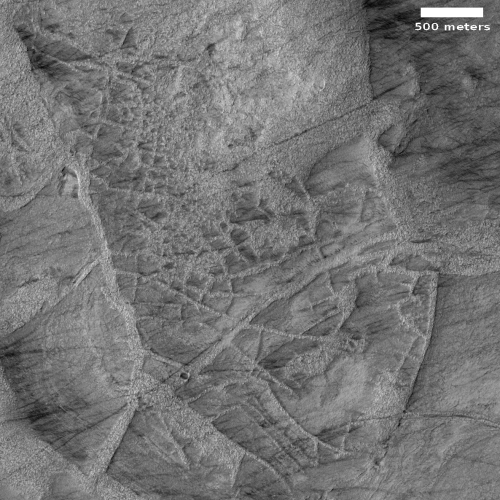Inexplicable ridges in Hellas Basin on Mars
Time for some more cool but mysterious Martian images! The photo to the right, rotated, cropped, and reduced to post here, is the first of two images today, both of which show the ridges but of a completely different nature. Both are located in Hellas Basin in Mars southern hemisphere.
This first picture was taken on September 4, 2020 by the high resolution camera on Mars Reconnaissance Orbiter (MRO), and shows a sinuous complex that resembles to a remarkable extent a set of river tributaries, but is instead a set of raised ridges rather than a canyon system.
Scientists have found more than 10,000 miles of such ridges in the northern hemisphere in Arabia Terra, the most extensive transition zone between the southern highlands and the northern lowlands, and have dubbed them fossilized rivers. From a 2016 press release:
The inverted channels are similar to those found elsewhere on Mars and Earth. They are made of sand and gravel deposited by a river and when the river becomes dry, the channels are left upstanding as the surrounding material erodes. On Earth, inverted channels often occur in dry, desert environments like Oman, Egypt, or Utah, where erosion rates are low – in most other environments, the channels are worn away before they can become inverted. “The networks of inverted channels in Arabia Terra are about 30m high and up to 1–2km wide, so we think they are probably the remains of giant rivers that flowed billions of years ago. Arabia Terra was essentially one massive flood plain bordering the highlands and lowlands of Mars. We think the rivers were active 3.9–3.7 billion years ago, but gradually dried up before being rapidly buried and protected for billions of years, potentially preserving any ancient biological material that might have been present,” added Joel Davis.
Nor are such features on Mars limited to Hellas and Arabia Terra. For a particularly spectacular feature in the cratered highlands see this 2019 post.
The origin of these sinuous ridges in Hellas might have a similar origin as these other fossilized rivers. At present the bottom of Hellas, the deepest basin on Mars, is a place with little signs of ice. In the past there is evidence that lakes once existed here, so we cannot rule out water as a cause.
At the same time, Hellas was formed by a gigantic impact. One cannot dismiss the possibility of a volcanic origin, impact melt left over from the heat of that crash.
Today’s second ridge complex in Hellas looks far different.

The photo to the right, rotated, cropped, and reduced to post here, was also taken by MRO’s high resolution camera on September 4, 2020. Unlike the sinuous ridges above, here we have cross-cutting ridges that more resemble the skeleton of a fish.
The cross-cutting nature of these ridges argues against them being a fossilized river. Instead, they suggest cracking and faults that became filled with material that was more resistant than the surrounding terrain and thus remained when that surrounding terrain eroded away. This hypothesis suggests cracks originally filled with lava.. Thus, these ridges could be evidence of the original impact melt that carved Hellas when that bolide smashed into Mars an estimated four billion years ago.
Or not. I am guessing wildly here.
The overview map to the right shows the location of these two pictures in Hellas Basin, with #1 the sinuous ridges and #2 the cross-cutting ones. That the sinuous ridges are in the southeast corner of the basin, close to regions where a lot of glaciers have been identified on the borders of Hellas, along with layers of ice in cliff scarps just outside Hellas, adds weight to the river theory of their formation. The deeper location of #2 fits better with the impact origin.
But as I said, these are still wild guesses. We would need a lot more information before these guesses become educated.
On Christmas Eve 1968 three Americans became the first humans to visit another world. What they did to celebrate was unexpected and profound, and will be remembered throughout all human history. Genesis: the Story of Apollo 8, Robert Zimmerman's classic history of humanity's first journey to another world, tells that story, and it is now available as both an ebook and an audiobook, both with a foreword by Valerie Anders and a new introduction by Robert Zimmerman.
The print edition can be purchased at Amazon or from any other book seller. If you want an autographed copy the price is $60 for the hardback and $45 for the paperback, plus $8 shipping for each. Go here for purchasing details. The ebook is available everywhere for $5.99 (before discount) at amazon, or direct from my ebook publisher, ebookit. If you buy it from ebookit you don't support the big tech companies and the author gets a bigger cut much sooner.
The audiobook is also available at all these vendors, and is also free with a 30-day trial membership to Audible.
"Not simply about one mission, [Genesis] is also the history of America's quest for the moon... Zimmerman has done a masterful job of tying disparate events together into a solid account of one of America's greatest human triumphs."--San Antonio Express-News
Time for some more cool but mysterious Martian images! The photo to the right, rotated, cropped, and reduced to post here, is the first of two images today, both of which show the ridges but of a completely different nature. Both are located in Hellas Basin in Mars southern hemisphere.
This first picture was taken on September 4, 2020 by the high resolution camera on Mars Reconnaissance Orbiter (MRO), and shows a sinuous complex that resembles to a remarkable extent a set of river tributaries, but is instead a set of raised ridges rather than a canyon system.
Scientists have found more than 10,000 miles of such ridges in the northern hemisphere in Arabia Terra, the most extensive transition zone between the southern highlands and the northern lowlands, and have dubbed them fossilized rivers. From a 2016 press release:
The inverted channels are similar to those found elsewhere on Mars and Earth. They are made of sand and gravel deposited by a river and when the river becomes dry, the channels are left upstanding as the surrounding material erodes. On Earth, inverted channels often occur in dry, desert environments like Oman, Egypt, or Utah, where erosion rates are low – in most other environments, the channels are worn away before they can become inverted. “The networks of inverted channels in Arabia Terra are about 30m high and up to 1–2km wide, so we think they are probably the remains of giant rivers that flowed billions of years ago. Arabia Terra was essentially one massive flood plain bordering the highlands and lowlands of Mars. We think the rivers were active 3.9–3.7 billion years ago, but gradually dried up before being rapidly buried and protected for billions of years, potentially preserving any ancient biological material that might have been present,” added Joel Davis.
Nor are such features on Mars limited to Hellas and Arabia Terra. For a particularly spectacular feature in the cratered highlands see this 2019 post.
The origin of these sinuous ridges in Hellas might have a similar origin as these other fossilized rivers. At present the bottom of Hellas, the deepest basin on Mars, is a place with little signs of ice. In the past there is evidence that lakes once existed here, so we cannot rule out water as a cause.
At the same time, Hellas was formed by a gigantic impact. One cannot dismiss the possibility of a volcanic origin, impact melt left over from the heat of that crash.
Today’s second ridge complex in Hellas looks far different.

The photo to the right, rotated, cropped, and reduced to post here, was also taken by MRO’s high resolution camera on September 4, 2020. Unlike the sinuous ridges above, here we have cross-cutting ridges that more resemble the skeleton of a fish.
The cross-cutting nature of these ridges argues against them being a fossilized river. Instead, they suggest cracking and faults that became filled with material that was more resistant than the surrounding terrain and thus remained when that surrounding terrain eroded away. This hypothesis suggests cracks originally filled with lava.. Thus, these ridges could be evidence of the original impact melt that carved Hellas when that bolide smashed into Mars an estimated four billion years ago.
Or not. I am guessing wildly here.
The overview map to the right shows the location of these two pictures in Hellas Basin, with #1 the sinuous ridges and #2 the cross-cutting ones. That the sinuous ridges are in the southeast corner of the basin, close to regions where a lot of glaciers have been identified on the borders of Hellas, along with layers of ice in cliff scarps just outside Hellas, adds weight to the river theory of their formation. The deeper location of #2 fits better with the impact origin.
But as I said, these are still wild guesses. We would need a lot more information before these guesses become educated.
On Christmas Eve 1968 three Americans became the first humans to visit another world. What they did to celebrate was unexpected and profound, and will be remembered throughout all human history. Genesis: the Story of Apollo 8, Robert Zimmerman's classic history of humanity's first journey to another world, tells that story, and it is now available as both an ebook and an audiobook, both with a foreword by Valerie Anders and a new introduction by Robert Zimmerman.
The print edition can be purchased at Amazon or from any other book seller. If you want an autographed copy the price is $60 for the hardback and $45 for the paperback, plus $8 shipping for each. Go here for purchasing details. The ebook is available everywhere for $5.99 (before discount) at amazon, or direct from my ebook publisher, ebookit. If you buy it from ebookit you don't support the big tech companies and the author gets a bigger cut much sooner.
The audiobook is also available at all these vendors, and is also free with a 30-day trial membership to Audible.
"Not simply about one mission, [Genesis] is also the history of America's quest for the moon... Zimmerman has done a masterful job of tying disparate events together into a solid account of one of America's greatest human triumphs."--San Antonio Express-News




Cool stuff!
Cthulhu tracks!
” … filled with material that was more resistant than the surrounding terrain and thus remained when that surrounding terrain eroded away. ”
The basalt ridges along the lower California Sierra foothills, within the gold bearing channel areas, have been recognized as ancient (river) lava flows which remained after the erosion of the surrounding areas, causing pronounced ridges with mesas now.
The ridges are really quite remarkable and beautiful in a foothill sort of way, at least when seen headed east along the highway 120 / 180 / and past the Keystone area.
Mars ? Who knows ?